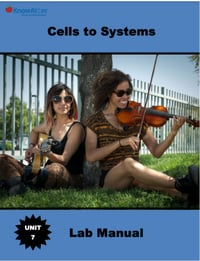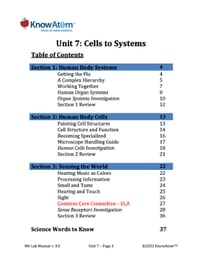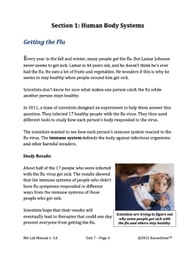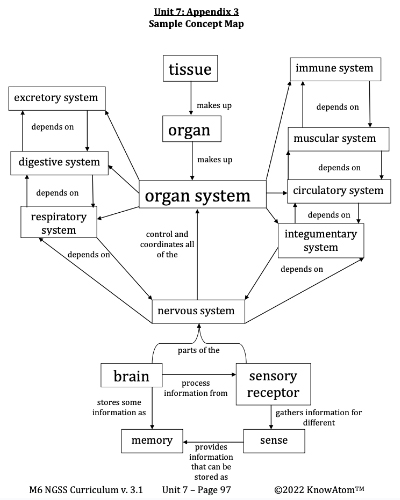The science background section gives teachers more detailed information on the phenomena students explore in this unit. Here is an excerpt of the science background section from this lesson on the human organ system structure and function.
Structure & Function of Cells
Every specialized cell has a unique shape that allows it to perform its specific tasks. For example, the primary job of red blood cells is to deliver oxygen to all of the cells in the body and return carbon dioxide to the lungs, where it can be released into the environment.
Red blood cells look like donuts without a hole in the middle. This shape makes it easy for gasses to move into and out of the cell because they have a large surface area. Red blood cells are also flexible, which helps them move through the body’s blood vessels, some of which are narrower than a human hair.
Red blood cells are unique among cells because they do not have a nucleus. A nucleus takes up space and increases the mass of the cell. A nucleus would mean there would be less space available for carrying oxygen and carbon dioxide, and the increased weight would make the heart have to work harder to move blood throughout the body.
Skin cells are different from red blood cells. They are part of the integumentary system, which provides a tough, physical barrier from the environment. Skin cells are layered, and each layer has a different shape. The first layers of skin cells are actually dead. The layers below are alive, and grow and reproduce frequently.
A Complex Hierarchy
Cells that are specialized for a specific function group together to form tissues. Animals (including humans) generally have four kinds of tissues: epithelial, connective, muscular, and nervous tissues. Skin cells are packed tightly together to form epithelial tissue, which serves as a barrier from the environment. Cardiac muscle cells form cardiac muscle tissue, while skeletal muscle cells form skeletal muscle tissue.
Two or more types of tissues that work together to carry out a specific function form structures called organs. Organs are made up of at least two types of tissues, and some are made up of all four. There are many different animal organs, including the heart, liver, lungs, mouth, muscles, and brain. The skin is the body’s largest organ.
Groups of organs that closely interact together to carry out specific functions are called organ systems. The immune system and the integumentary system are two organ systems. Other organ systems include the circulatory, respiratory, and digestive systems. Each system is composed of many cells and keeps the organism functioning properly.
Every organ system requires that each of its parts functions properly in order to perform its job. Organ systems also depend on other organ systems to function. For example, the digestive system is responsible for breaking down food into energy that can be used by cells in the body. It includes the mouth, esophagus, stomach, intestines, liver, and the pancreas. The digestive system breaks down complex food molecules into single glucose molecules that can be absorbed by cells in the small intestine. These cells transport the molecules into the blood stream so that other cells in the body can use them. The excretory system removes the waste.
Working Together
The blood stream that carries nutrients throughout the body is part of the circulatory system, which distributes blood, oxygen, and nutrients to the body’s cells and carries away waste products.
It includes the heart, which is the body’s hardest-working organ. The heart beats approximately 100,000 times every day. It also includes blood vessels, which are hollow tubes that serve as the body’s highways. They circulate blood from the heart to every region in the body and back again. Blood is a liquid connective tissue. It travels thousands of miles in blood vessels, carrying nutrients, water, oxygen, and waste products to and from the body’s cells.
The heart is also a muscle. Because of this, it is also part of the muscular system, which is the organ system that enables an organism to move. It is responsible for all of your body’s movement. This includes movements that you direct, including lifting your arms or walking. It also includes the beating of your heart and the movement of blood through your body. Muscle tissues contract and relax to move your body parts.
The process that breaks down complex food molecules into single glucose molecules requires oxygen. The respiratory system brings in oxygen from the environment that cells need to function, and releases carbon dioxide, a waste product. It is made up of airways, lungs, and muscles of respiration. The circulatory system distributes the oxygen and carbon dioxide throughout the body.
Finally, the nervous system has to coordinate and control all of this activity. It is made up of the brain, spinal column, sensory organs, and nerve cells (which are also called neurons).








